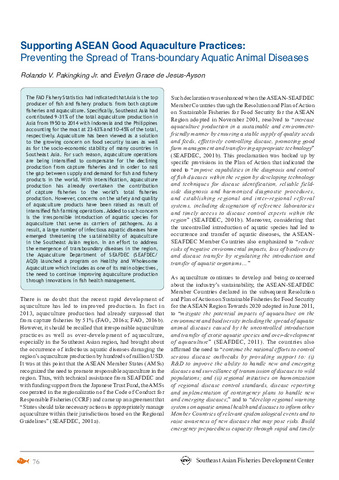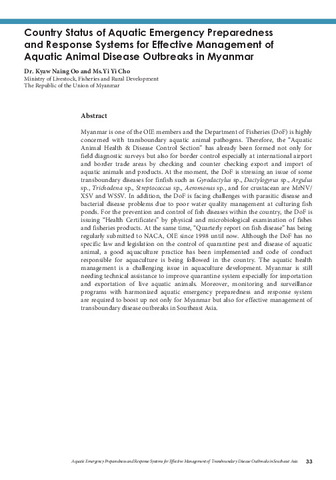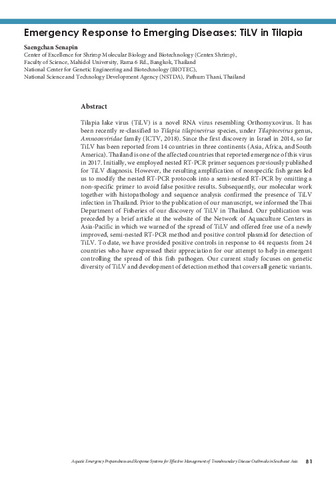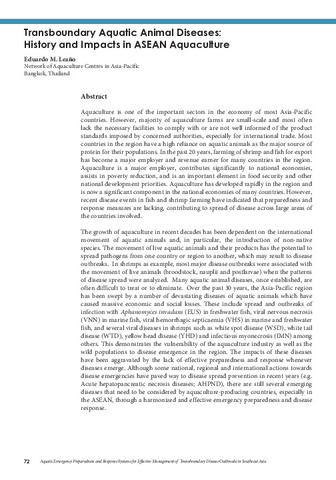Supporting ASEAN good aquaculture practices: Preventing the spread of trans-boundary aquatic animal diseases
Share
นามธรรม
The FAO Fishery Statistics had indicated that Asia is the top producer of fish and fishery products from both capture fisheries and aquaculture. Specifically, Southeast Asia had contributed 9-31% of the total aquaculture production in Asia from 1950 to 2014 with Indonesia and the Philippines accounting for the most at 23-63% and 10-45% of the total, respectively. Aquaculture has been viewed as a solution to the growing concern on food security issues as well as for the socio-economic stability of many countries in Southeast Asia. For such reason, aquaculture operations are being intensified to compensate for the declining production from capture fisheries and in order to nail the gap between supply and demand for fish and fishery products in the world. With intensification, aquaculture production has already overtaken the contribution of capture fisheries to the world’s total fisheries production. However, concerns on the safety and quality of aquaculture products have been raised as a result of intensified fish farming operations. Added to such concern is the irresponsible introduction of aquatic species for aquaculture that serve as carriers of pathogens. As a result, a large number of infectious aquatic diseases have emerged threatening the sustainability of aquaculture in the Southeast Asian region. In an effort to address the emergence of transboundary diseases in the region, the Aquaculture Department of SEAFDEC (SEAFDEC/AQD) launched a program on Healthy and Wholesome Aquaculture which includes as one of its main objectives, the need to continue improving aquaculture production through innovations in fish health management.
การอ้างอิง
Pakingking Jr., R. V., & de Jesus-Ayson, E. G. (2016). Supporting ASEAN good aquaculture practices: Preventing the spread of trans-boundary aquatic animal diseases. Fish for the People , 14(2), 76-82. http://hdl.handle.net/20.500.12066/985
เรื่อง
คอลเลกชัน
รายการที่เกี่ยวข้อง
แสดงรายการที่เกี่ยวข้องตามชื่อผู้แต่งผู้สร้างและเรื่อง
-
Country status of aquatic emergency preparedness and response systems for effective management of aquatic animal disease outbreaks in Myanmar
Oo, Kyaw Naing; Cho, Yi Yi (Aquaculture Department, Southeast Asian Fisheries Development Center, 2019)Myanmar is one of the OIE members and the Department of Fisheries (DoF) is highly concerned with transboundary aquatic animal pathogens. Therefore, the Aquatic Animal Health & Disease Control Section has already been ... -
Emergency response to emerging diseases: TiLV in tilapia
Senapin, Saengchan (Aquaculture Department, Southeast Asian Fisheries Development Center, 2019)Tilapia lake virus (TiLV) is a novel RNA virus resembling Orthomyxovirus. It has been recently re-classified to Tilapia tilapinevirus species, under Tilapinevirus genus, Amnoonviridae family (ICTV, 2018). Since the first ... -
Transboundary aquatic animal diseases: History and impacts in ASEAN aquaculture
Leaño, Eduardo M. (Aquaculture Department, Southeast Asian Fisheries Development Center, 2019)Aquaculture is one of the important sectors in the economy of most Asia-Pacific countries. However, majority of aquaculture farms are small-scale and most often lack the necessary facilities to comply with or are not well ...





